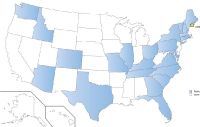| |
|
Communities served
by COSEE-OS | |
|
Since 2005, COSEE-OS has been creating & testing models of collaboration, particularly with respect to reaching rural and inland audiences, engaging ocean researchers, and creating transferable activities for classroom education. In this presentation, we:
- Summarize COSEE-OS' strides in reaching rural and inland audiences.
Describe how COSEE-OS has increased the capacity of scientists to efficiently translate their research into compelling and relevant content for various audiences by helping them deconstruct knowledge into concepts for construction of concept maps.
Conduct two activities illustrating transferability between ocean science content and standard physical science and terrestrial ecological concepts.
The session began with a Powerpoint presentation describing the COSEE-OS mission and goals, particularly with respect to: reaching rural & inland audiences; engaging ocean researchers; and creating transferable activities for classroom education. In our workshops, almost 50% of our participants have come from rural or inland areas of the country. With respect to engaging scientists and helping them translate their research to wider audiences, the presentation described one example of how the concept mapping tools have been used successfully to refine the science content message while at the same time providing a meaningful context for collaboration among researchers and educators.
|
|
Program applicants and
participants by state (blue) | |
|
The presentation paused to give session participants a chance to do one of our “transferable activities”. The first activity came from our recent publication
Teaching Physical Concepts in Oceanography and allowed learners to observe effects of temperature and salinity on density and stratification. Participants were provided with a few materials (bowls, beakers, water, ice, salt and food coloring) and they “played” with different mixtures to create stratified water layers. The booklet expands on this activity by providing teachers detailed information about the significance of stratification for ocean systems. The presentation resumed with video clips illustrating global temperature, salinity, and density patterns and a discussion by Dr. Susan Lozier about the importance of these properties in oceans.
The session closed with another transferable activity, this time from ecology rather than physical science. Two articles published by Science Daily offered examples from the scientific literature about effects on ecosystems stemming from impacts to a top predator in each system -- in one case wolves and in another sharks. Each article described a “trophic cascade” and incorporated many of the same ecological principles and ideas. Session participants were split into two groups -- "wolves" and "sharks" -- and were asked to form small teams within each predator group. They were provided with a worksheet and were asked to read the article pertaining to their predator.' On the worksheet they wrote terms from the article that related to major concepts from the Ecology Unit of the Philadelphia public school system (the city where the conference was being held). They were instructed to use their terms/concepts to construct a concept map illustrating the relationships and ideas described in the article.
The take-home message for this and the earlier activity was: Activities normally used in non-ocean science classes (observing temperature and salinity effects on density; or using terrestrial examples to discuss ecological relationships) can easily be adapted to incorporate ocean science content and concepts (such as ocean stratification and ocean ecosystems) and can still address the same learning standards and content goals. Additional content is not needed!
Videos played during the lecture at slides 12 and 13 can be found here:
Try some of these activities in your classroom and let us know how it goes!
This presentation was written by Annette deCharon, Medea H. Steinman, and Amy Holt-Cline and was presented at the 2010 NSTA National Conference in Philadelphia, PA







